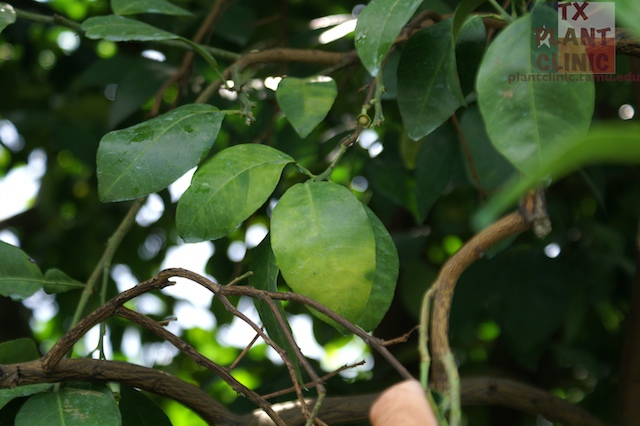Citrus Greening Awareness
Warnings about a devastating citrus plant disease are targeted at consumers, educators, homeowners, gardeners as well as growers in Texas.
This disease is called the Citrus Greening Disease (CG), or Huanglongbing, caused by the bacterium Candidatus Liberibacter asiaticus, which is vectored by the Asian Citrus Psyllid (ACP) insect.
Since 2005, CG has surfaced in multiple places in the U.S. It was first found in Florida, where the disease has since impacted the citrus industry. An infected plant and infected psyllids were found in Louisiana in 2008. Since then, this disease has been discovered in Georgia and South Carolina.
Fortunately, this disease pathogen has NOT been found in Texas. The insect vector is in south Texas, but no infected psyllids (to date) has been detected. On January 13, 2012 – USDA and TDA released information that Citrus Greening was found and confirmed in Hidalgo county. In spring of 2014, Hidalgo and Cameron counties were placed under CG quarantine. In July 2014, Harris county was placed under Citrus Greening quarantine. As of 10/9/2014 – Fort Bend and Montgomery counties are also included in the CG quarantine. The Harris, Fort Bend & Montgomery counties quarantine is known as the Gulf Coast Quarantine. As of 10/07/2019, the Citrus Greening quarantine area has expanded and encompasses 4 specified quarantine areas: This include the Upper Gulf Coast (Harris, Fort Bend, Montgomery, Galveston & Brazoria); Coastal Bend (Aransas, Calhoun, Kleberg & Nueces); Webb County; and the Valley (Brooks, Cameron, Hidalgo, Jim Hogg, Kenedy, Starr and Willacy)
In order to prevent citrus greening from getting a foothold in the state, residents should be aware of what to look for, who to contact for assistance, and to report potential finds. AgriLife Extension offers seminars, training programs and resources to assist Texas residents in identifying potential cases.
WHY look for signs of citrus greening?
- There is currently no cure for an infected tree, so prevention is essential.
- Early detection and action help to limit spread of disease.
- Areas where citrus is grown must be protected from this devastating disease.
RESOURCES developed by the Texas Plant Disease Diagnostic Laboratory in cooperation with various colleagues and entities are listed below and available to the general public.
PRINT PUBLICATIONS
Awareness Information factsheet
Texas Upper Gulf Coast Citrus Greening quarantine awareness information card
The purpose of this factsheet is for rapid dissemination of information on the current quarantine in the Upper Gulf Coast region and general citrus greening information to general public. Rudimentary and basic disease and symptom description are provided along with the notice that quarantined plants CANNOT be moved out of the quarantined counties and any movement of citrus plant material may be subject to Texas Department of Agriculture regulations.
Citrus Greening Coloring and Activity Book
CG Activity book rev.2012- small file (1.2MB)
Asian Citrus Psyllid treatment poster*
* poster is primarily directed to citrus producers and contain current insecticide recommendations for suppression of Asian Citrus Psyllid.
ACP treatment Poster (22.50 x 30.00 in) – ~1Mb
VIDEO RESOURCES
Citrus Health Response video series (Youtube videos – AgriLifeVideo):
Citrus Disease Guide
If you find or have suspected citrus with Citrus Greening symptoms or the Asian Citrus Psyllid, please contact the:
Texas Department of Agriculture
800-835-5832
or your local AgriLife Extension county office for assistance
Online AgriLife Extension county office locator
You may also contact us for additional guidance on sampling and confirmatory analysis.
Texas Plant Disease Diagnostic Laboratory
1500 Research Parkway, Suite A130, College Station, TX 77845
Phone: (979) 845-8032, Fax: (979) 845-6499
Email: plantclinic@tamu.edu
